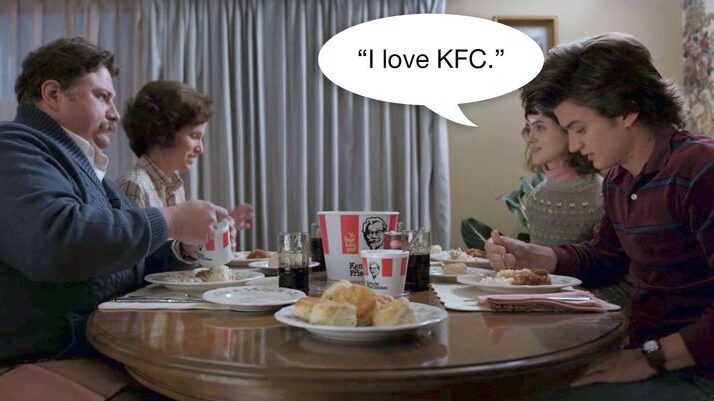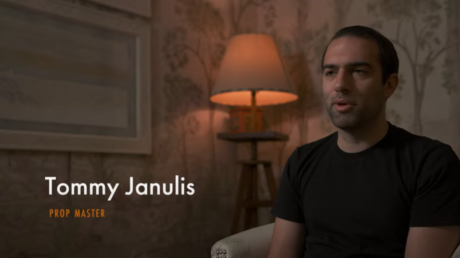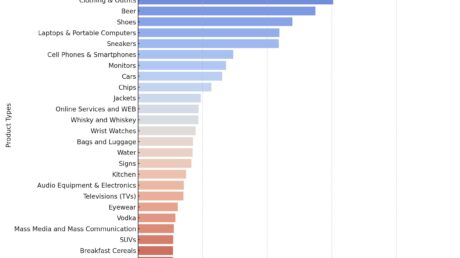Brands have dominated cultural conversations in entertainment. “Stranger Things” didn’t randomly include a bucket of KFC in the Netflix-acclaimed show. That was strategic product placement—and brands and the agencies representing them use these integrations to authentically connect with viewers.
Read on to see how product placement integrates brands into modern culture, while also providing significant results along the way.
What is product placement?
Product placement can put brands on the map by featuring their products in feature films, broadcast, cable programming, and streaming services. Product placement naturally weaves products into content and allows viewers to stay immersed in the story while providing big benefits for brands.
Case in point: General Mills. The brand reached difficult-to-reach teen consumers by placing their cereal, Cheerios, in popular content. Aligning Cheerios with characters and storylines on streaming platforms and linear TV made General Mills culturally relevant. And, the integrations influenced purchasing decisions and drove more positive opinions of the brand.
What else is product placement called?
The entertainment industry often refers to product placements as brand integrations and truth be told, there’s no difference between the terms. In the past, a brand integration indicated a paid placement, and product placement was not paid. However, times have changed, and people use the terms interchangeably.
What are the different approaches to product placement, and which is the right fit for brands?
Of product placement’s four approaches, each can help a brand become culturally relevant and achieve their desired KPIs. It really comes down to goals and timing.
- Story-driven placements: Story-driven placements, also known as a narrative placement, can define a character or even help drive the story forward, like Netflix’s “Stranger Things.” The character Eleven’s waffle obsession made Eggo Waffles the talk of the town, and Kelloggs can trace skyrocketing sales directly to the show. Eggo’s revenue jumped 9.4% during the first half of 2018 — which is when season 2 aired.
- Prop placements: Productions using a brand’s products as props. Brands with different types of packaged goods, fashion, or electronics are often well suited for prop placement. Although this approach is usually a lower cost option, prop placement is highly effective, and the results look the same. When Netflix’s Gente-fied featured the iconic scene with Hot Cheetos being eaten with chopsticks, the brand saw a 4% increase in purchase intent. And not to mention the show’s actors enjoyed a tasty snack, making this integration a win all around. .
- Branded content: Typically included in daypart or late-night series, branded content does wonders for brands with time-sensitive messages by allowing them to educate their consumers with deeper messaging. When considering branded content opportunities, it’s important to note that they tend to be more expensive and work best for brands with shorter-term objectives. An excellent example of branded content is Jimmy Kimmel Live! filming live from Las Vegas for a week and featuring popular brands like Mazda, Caesars Entertainment, and even the city of Las Vegas itself.
- Virtual placements: Virtual product placement uses cutting-edge technology to insert brands on a product, logo, or billboard into content in post-production. Production partners are diligent in ensuring that these placements work for the storyline and brand so the placement enhances the viewer’s experience. While virtual placements are quick to implement, they have limited content opportunities, and don’t always remain evergreen.
How can brands benefit from product placement?
Product placement can be a total game-changer for brands. Integrations help brands connect with traditionally hard-to-reach audiences by getting their products into programs they already love, therefore creating authentic connections that boost brand awareness, drive sales, and insert them into the cultural conversation. Another great thing about product placement? It’s the gift that keeps on giving. Unlike commercials that run until hitting a specific number of impressions, integrations aren’t held to these restrictions. They can last a lifetime, giving brands a chance to connect with audiences time and time again.
Is product placement safe for brands?
Safety matters, which is why many brands pursue product placement. It’s highly specific unlike a traditional or digital media buy where an ad could very well end up in places that could damage a brand’s reputation. Consider working with an experienced product placement agency who knows all the ins and outs of the industry and can ensure brands land in the perfect place.
Why do production partners want to use brands’ real products instead of fake ones?
Brands’ products provide production partners real value. Compared to creating fake ones, real products are more cost-effective and better for their creative visions. With product placement, production partners don’t have to source products, which frees up budget dollars that they can use elsewhere. Plus, fake products take viewers out of the story whereas real products offer a more authentic and immersive experience. Viewers would hardly recognize “Top Gun’s” Lieutenant Pete “Maverick” Mitchell without his sleek, black Ray-Bans. That trademark look is something a generic prop could never accomplish.
What types of brands does product placement make sense for? Will it work for smaller brands?
Any brand can benefit from well-done product placement. Big player CarMax, the biggest U.S. used car retailer, had a 20-plus point lift in their overall brand rating from using product placement via on-screen moments, late night TV, and scripted and unscripted content.
Product placement can have major rewards too for smaller brands, like Go RVing, a company striving to motivate potential RVers. The company wanted to go big with product placement during the summer traveling season and launched a road trip series with “The Ellen Degeneres Show.” The integration drove (pun most certainly intended) remarkable results for Go RVing, who received over 15 million views/impressions and 440-plus million social media impressions.
As a truly authentic and effective form of advertising, product placement can yield measurable results for brands of all sizes.
Does product placement drive results?
Any campaign starts with defining brand objectives and brands can see whether product placement is effective in reaching these objectives through full-funnel measurements that align with their performance indicators. This might include:
- Attribution Reports that connect first or third-party sales data with audience exposure data to evaluate sales lift or website visits lift from integrations;
- Brand Lift Studies that provide custom market research to understand integrations’ impact on recall, opinion, purchase intent, and key brand attributes;
- Media Mix Modeling (MMM) Integration refers to integrating data into existing media mix models to measure a product placement’s impact.
- Earned Media Value: Measuring media value can be another form of proving ROI for product placement. Similar to measuring media value on traditional marketing formats, earned media value for product placement is the monetary value of the product placement exposure put into a quantitative dollar amount representing what is presumed to have been the same engagement through paid branded marketing channels. However, calculating media value for product placement is not exactly 1:1 as it would be for other paid marketing channels, and there are several industry leaders creating their own methodology for calculating media value for product placement moments. SEE HERE for a recent article on YouGov and the PQS tool for an example.
Transparent reporting and cutting-edge measurement solutions allow brands to track ROI based on brand lift, sales attribution, or integration into existing media mix models.
What’s the timeline for product placement?
With some advanced planning, product placement can produce transformative results for any brand. A leading home security brand learned that the results are worth the wait when placing their products in premium cable programming, streaming content, and feature films, which required between 7 to 11 months in lead time. The security brand’s placements in Showtime’s “Billions,” Netflix’s “Never Have I Ever,” and Paramount’s “Playing with Fire” generated a 61% increase in viewers reporting consideration to purchase.
Typical “content gestation” periods range from:
- 3-6 months for daytime and late-night programs
- 3-9 months for broadcast and cable television
- 6-12 months+ for streaming/premium cable
- 12-15 months for feature films
Why work with an agency partner?
Once brands work with an agency partner, they rarely go solo again. Agency partners serve as extensions of the brand. Using deep-rooted relationships and industry expertise, a successful agency partner ensures production partners positively position brands in content. It’s important for brands to work with an agency partner that targets opportunities that line up with campaign’s KPIs. That way, the partner finds opportunities that educate a brand’s target audiences on their products, philosophy, ideal character and integration scenarios, and brand guidelines.
At the end of the day, numbers talk. Agency partners will provide detailed reporting and insights to optimize and refine a product placement strategy to strengthen year-over-year performance.
How do agency partners secure the strongest placement for brands?
When looking for an agency partner, brands should seek ones with deep-rooted connections in the entertainment industry. Agency partners use their industry experience and relationships to connect brands with content opportunities to reach their goals and audience in an impactful way.
What does the approval process look like for brands?
Both brands and production partners want a successful placement that is authentic to the creative vision and a brand’s essence. Brands working with agency partners can start by ensuring the agency understands their goals and target the right opportunities based on KPIs and brand guidelines, including do’s and don’ts.
Putting in the work in the planning stages and casting a wide net for integrations may open exciting new doors that align a brand with the next big thing. While brands don’t have final approval on content, they can count on integrations that fulfill mutually agreed-upon criteria as outlined in the contract.
Can brands select their choices for specific productions and actors?
Successful product placements focus more on aligning productions to a brand’s goal, versus checking a specific box for a coveted actor or hot new show. That’s where an agency partner comes in. They can form a strategy to source opportunities that match a brand’s preferences and KPIs. It’s better to cast a wider net to allow for a wider range of opportunities and a great chance for a dynamite partnership. After all, some of entertainment’s most iconic productions are ones that people didn’t see coming.
Does product placement give brands a guaranteed amount of screen time?
Generally, there is no guaranteed amount of time that brands will spend on screen, as it depends on the programs’ storyline.




